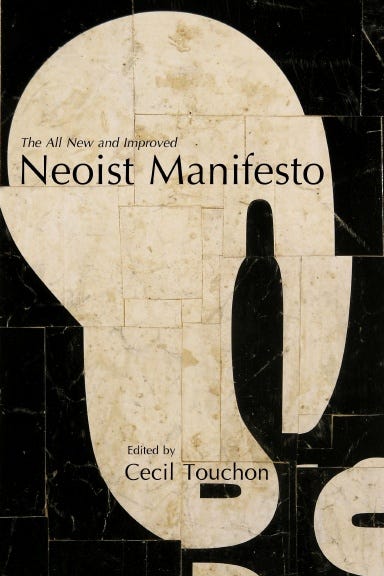The following is an amplification of writings by Cecil Touchon related to the Neoist Manifesto - A Trans-Lingual Edition
BUY NOW: The Neoist Manifesto - Documents of Neoism - The Neoist Society By Cecil Touchon
The Fire of Art: Against the Historicization of Imagination
Artistic creativity is like fire. It needs no justification, no inheritance, no permission. Fire arises when the conditions are right—oxygen, fuel, and a spark—and so too do ideas. They ignite wherever atmosphere and attention meet: in a child’s sketch, a poet’s daydream, or a hacker’s midnight code. The conditions are general, not particular. They appear everywhere and nowhere at once, as spontaneous as weather, as unpredictable as wind.
Yet the institutions of art, and especially its historians, have made a practice of treating fire as property. They want to locate it: to name the first flame, to record who lit it, to measure its influence, to trace its descent into smoke. This is how the living fire of imagination is captured and cooled, turned into artifact, theory, and finally, commodity.
The Neoist Society, if we take its spirit seriously, recognizes this as a form of intellectual enclosure. The effort to tie creativity to a time, a place, or a personality serves not understanding, but valuation. It allows collectors and museums to claim ownership over the ineffable by tying it to provenance. Once an artwork is fixed within a historical narrative, it becomes an instrument of power—a certificate of authenticity for wealth and institutional prestige.
But creativity itself has no provenance. It is a continual combustion of perception and possibility. Every artist draws from a universal reservoir of potential, which cannot be owned or exhausted. The painter in Lagos, the collagist in Oaxaca, the coder in Seoul—all touch the same invisible current. The fire that moved the cave painters of Lascaux moves still in every gesture of invention.
To work as an artist today is, therefore, to keep that current alive and unconfined. One must resist the reduction of art to an episode in cultural accounting. Instead, art can be seen as a recurring phenomenon of consciousness itself: a radiant field that flares up wherever human beings seek to translate mystery into form.
In this sense, the true task of the artist is not to innovate within history, but to undermine history’s claim of jurisdiction over imagination. For history is a museum of ashes, while art remains the living fire.



